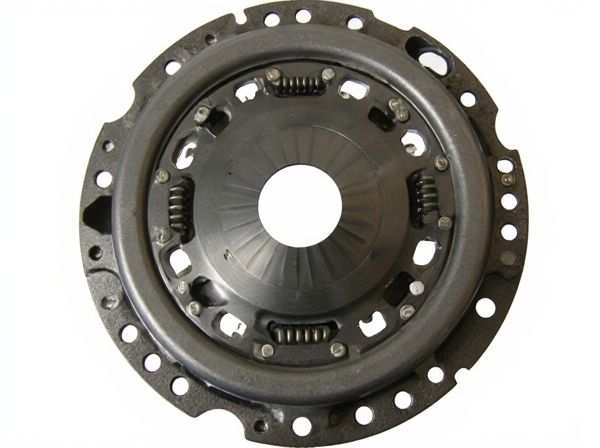
Photo illustration: Sprung Hub Clutch vs Rigid Hub Clutch
A Sprung Hub Clutch offers smoother engagement and better vibration absorption, enhancing ride comfort and reducing drivetrain shock. A Rigid Hub Clutch provides a more direct power transfer, ideal for riders seeking maximum responsiveness and durability under high torque conditions. Your choice depends on whether you prioritize comfort or performance in demanding riding environments.
Table of Comparison
| Feature | Sprung Hub Clutch | Rigid Hub Clutch |
|---|---|---|
| Vibration Dampening | High - absorbs engine and drivetrain shocks | Low - transfers vibrations directly |
| Driving Comfort | Improved - smoother engagement and disengagement | Reduced - harsher clutch operation |
| Torque Handling | Moderate - suitable for daily driving and moderate power | High - ideal for high-performance and racing applications |
| Durability | Moderate - springs may wear out over time | High - solid construction with less wear components |
| Cost | Lower - affordable and common in standard vehicles | Higher - premium for performance-focused vehicles |
| Maintenance | Periodic spring inspection recommended | Minimal - fewer moving parts to service |
| Application | Everyday cars, commuter vehicles | Sport cars, racing, heavy-duty performance |
Introduction to Sprung Hub and Rigid Hub Clutches
Sprung hub clutches utilize coil springs to absorb and cushion torque transfer, reducing drivetrain shock and improving ride comfort, making them ideal for off-road and performance motorcycles. Rigid hub clutches feature a solid, non-flexible connection between the clutch hub and sprocket, providing direct power transfer with minimal slippage but resulting in harsher engagement. Understanding the mechanical differences helps riders choose the best clutch type based on riding style and terrain demands.
Key Differences Between Sprung and Rigid Hub Clutches
Sprung hub clutches feature integrated springs that absorb shock and reduce drivetrain vibrations, enhancing rider comfort and prolonging component life, whereas rigid hub clutches provide a direct, no-slip connection that maximizes power transfer and improves acceleration responsiveness. The primary difference lies in the damping mechanism; sprung hubs use torsion springs to cushion engagement, while rigid hubs eliminate any play for immediate power delivery. Choosing between them depends on the desired balance between smoothness and direct mechanical feedback in motorcycle performance.
How a Sprung Hub Clutch Works
A Sprung Hub Clutch uses a series of springs to absorb and dampen engine torque fluctuations, providing smoother power delivery and reducing drivetrain shock. The springs allow gradual engagement of the clutch, minimizing sudden jerks during gear shifts or acceleration. This design enhances vehicle drivability and extends the lifespan of transmission components compared to a Rigid Hub Clutch, which locks directly without cushioning torque variations.
How a Rigid Hub Clutch Functions
A rigid hub clutch functions by directly connecting the clutch hub to the clutch basket, eliminating any cushioning or damping elements found in sprung hub designs. This direct engagement allows for immediate power transfer from the engine to the transmission, resulting in a more responsive and aggressive throttle feel. Rigid hub clutches are preferred in high-performance and racing applications where precise power delivery and minimal drivetrain slip are critical.
Performance Impact: Sprung vs Rigid Hub
Sprung hub clutches absorb torsional vibrations and shocks, enhancing drivetrain smoothness and reducing stress on transmission components, which improves acceleration and riding comfort. Rigid hub clutches provide direct power transfer with minimal slippage, resulting in more immediate throttle response and power delivery but increased wear on clutch plates and harsher engagement. Choosing between sprung and rigid hubs affects overall vehicle performance, balancing smoothness versus responsiveness depending on rider preference and application.
Noise and Vibration Comparison
Sprung hub clutches typically reduce noise and vibration by absorbing shock and damping drivetrain impact, resulting in smoother operation and quieter performance. Rigid hub clutches, however, directly transfer torque without cushioning, which can cause increased noise and vibration under load. Riders seeking lower NVH (Noise, Vibration, Harshness) levels often prefer sprung hubs for enhanced comfort and longevity of transmission components.
Durability and Maintenance Considerations
Sprung hub clutches provide enhanced durability by absorbing shock loads, reducing wear on transmission components and extending overall clutch life, which decreases maintenance frequency. Rigid hub clutches offer a more direct power transfer with fewer moving parts, resulting in simpler maintenance but increased susceptibility to wear under heavy shock loads. Choosing between the two depends on balancing durability needs with maintenance schedules, where sprung hubs are preferable for harsh conditions requiring longevity, and rigid hubs suit applications favoring straightforward upkeep.
Suitability for Street vs Track Use
Sprung hub clutches provide smoother engagement and better vibration absorption, making them ideal for street riding by enhancing comfort and reducing drivetrain shock in stop-and-go traffic. Rigid hub clutches deliver direct power transfer and quicker response, which suits aggressive track conditions where precision and immediate throttle feedback are essential. Choosing between the two depends on prioritizing street-friendly smoothness or track-focused performance and control.
Cost Comparison: Sprung vs Rigid Hub Clutch
Sprung hub clutches generally incur higher initial costs due to their complex design featuring springs that absorb shocks and reduce drivetrain vibrations. Rigid hub clutches have lower manufacturing and maintenance expenses, as their simpler construction lacks damping components. Over time, the sprung hub may offer cost savings by minimizing wear on transmission parts, whereas rigid hubs can lead to increased repair costs from harsher engagement forces.
Choosing the Right Clutch for Your Vehicle
Sprung hub clutches offer smoother engagement and reduced drivetrain shock, making them ideal for vehicles prioritizing comfort and longevity in everyday driving. Rigid hub clutches provide direct power transfer with minimal slippage, preferred in high-performance or racing applications where immediate throttle response is critical. Selecting the right clutch depends on balancing driving conditions, vehicle purpose, and desired performance, with sprung hubs excelling in daily use and rigid hubs favored for aggressive, high-torque demands.
 caratoz.com
caratoz.com